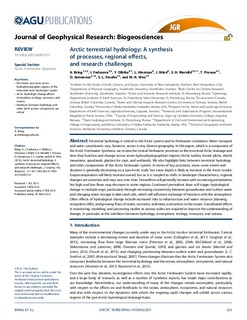| dc.description.abstract | Terrestrial hydrology is central to the Arctic system and its freshwater circulation. Water transport and water constituents vary, however, across a very diverse geography. In this paper, which is a component of the Arctic Freshwater Synthesis, we review the central freshwater processes in the terrestrial Arctic drainage and how they function and change across seven hydrophysiographical regions (Arctic tundra, boreal plains, shield, mountains, grasslands, glaciers/ice caps, and wetlands). We also highlight links between terrestrial hydrology and other components of the Arctic freshwater system. In terms of key processes, snow cover extent and duration is generally decreasing on a pan-Arctic scale, but snow depth is likely to increase in the Arctic tundra. Evapotranspiration will likely increase overall, but as it is coupled to shifts in landscape characteristics, regional changes are uncertain and may vary over time. Streamflow will generally increase with increasing precipitation, but high and low flows may decrease in some regions. Continued permafrost thaw will trigger hydrological change in multiple ways, particularly through increasing connectivity between groundwater and surface water and changing water storage in lakes and soils, which will influence exchange of moisture with the atmosphere. Other effects of hydrological change include increased risks to infrastructure and water resource planning, ecosystem shifts, and growing flows of water, nutrients, sediment, and carbon to the ocean. Coordinated efforts in monitoring, modeling, and processing studies at various scales are required to improve the understanding of change, in particular at the interfaces between hydrology, atmosphere, ecology, resources, and oceans. | nb_NO |

